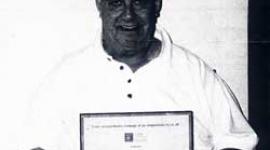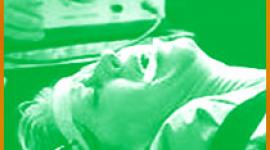Testimony of Leonard Roy Frank on Electroconvulsive Treatment
TESTIMONY OF LEONARD ROY FRANK AT A PUBLIC HEARING ON ELECTROCONVULSIVE "TREATMENT" BEFORE THE MENTAL HEALTH COMMITTEE OF THE NEW YORK STATE ASSEMBLY, MARTIN A. LUSTER (CHAIRMAN), MANHATTAN, 18 MAY 2001
My name is Leonard Roy Frank, from San Francisco, and I'm here representing the Support Coalition International based in Eugene, Oregon. SCI unites 100 sponsoring groups who oppose all forms of psychiatric oppression and support humane approaches for assisting people said to be "mentally ill." This year the United Nations recognized Support Coalition International as "a Non-Governmental Organization with Consultative Roster Status."
I've taken the epigraph for my presentation from a talk on the Holocaust by Hadassah Lieberman, the wife of Sen. Joseph Lieberman, which was rebroadcast on C-SPAN last month. She quoted the Bal Shem Tov, founder of Hasidism: "In remembrance lies the secret of redemption."
Introduction
 Some personal background is relevant to the substance of my testimony: I was born in 1932 in Brooklyn and was raised there. After graduating from the Wharton School at the University of Pennsylvania, I served in the U.S. Army and then worked as a real estate salesman for several years. In 1962, three years after moving to San Francisco, I was diagnosed as a "paranoid schizophrenic" and committed to a psychiatric institution where I was forcibly subjected to 50 insulin-coma and 35 electroconvulsive procedures.
Some personal background is relevant to the substance of my testimony: I was born in 1932 in Brooklyn and was raised there. After graduating from the Wharton School at the University of Pennsylvania, I served in the U.S. Army and then worked as a real estate salesman for several years. In 1962, three years after moving to San Francisco, I was diagnosed as a "paranoid schizophrenic" and committed to a psychiatric institution where I was forcibly subjected to 50 insulin-coma and 35 electroconvulsive procedures.
This was the most painful and humiliating experience of my life. My memory for the three preceding years was gone. The wipe-out in my mind was like a path cut across a heavily chalked blackboard with a wet eraser. Afterwards, I didn't know that John F. Kennedy was president although he had been elected three years earlier. There were also big chunks of memory loss for events and periods spanning my entire life; my high school and college education was effectively destroyed. I felt that every part of me was less than what it had been.
Following years of study reeducating myself, I became active in the psychiatric survivors movement, becoming a staff member of Madness Network News (1972) and co-founding the Network Against Psychiatric Assault (1974) -- both based in San Francisco and dedicated to ending abuses in the psychiatric system. In 1978 I edited and published The History of Shock Treatment. Since 1995, three books of quotations I edited have been published: Influencing Minds, Random House Webster's Quotationary, and Random House Webster's Wit & Humor Quotationary.
Over the last thirty-five years I have researched the various shock procedures, particularly electroshock or ECT, have spoken with hundreds of ECT survivors, and have corresponded with many others. From all these sources and my own experience, I have concluded that ECT is a brutal, dehumanizing, memory-destroying, intelligence-lowering, brain-damaging, brainwashing, life-threatening technique. ECT robs people of their memories, their personality and their humanity. It reduces their capacity to lead full, meaningful lives; it crushes their spirits. Put simply, electroshock is a method for gutting the brain in order to control and punish people who fall or step out of line, and intimidate others who are on the verge of doing so.
Brain Damage
Brain damage is the most important effect of ECT. Brain damage is, in fact, the 800-pound gorilla in the living room whose existence psychiatrists refuse to acknowledge, at least publicly. Nowhere is this more clearly illustrated than in the American Psychiatric Association's 2001 Task Force Report on The Practice of Electroconvulsive Therapy: Recommendations for Treatment, Training, and Privileging, 2nd ed. (p. 102), which states that "in light of the accumulated body of data dealing with structural effects of ECT, 'brain damage' should not be included [in the ECT consent form] as a potential risk of treatment."
But 50 years ago, when some proponents were careless with the truth about ECT, Paul H. Hoch, co-author of a major psychiatric textbook and New York State's Commissioner of Mental Hygiene, commented, "This brings us for a moment to a discussion of the brain damage produced by electroshock.... Is a certain amount of brain damage not necessary in this type of treatment? Frontal lobotomy indicates that improvement takes place by a definite damage of certain parts of the brain." ("Discussion and Concluding Remarks," Journal of Personality, 1948, vol. 17, pp. 48-51)
More recently, neurologist Sidney Sament backed the brain-damage charge in a letter to Clinical Psychiatry News (March 1983, p. 11):
"After a few sessions of ECT the symptoms are those of moderate cerebral contusion, and further enthusiastic use of ECT may result in the patient functioning at a subhuman level.
Electroconvulsive therapy in effect may be defined as a controlled type of brain damage produced by electrical means....
In all cases the ECT 'response' is due to the concussion-type, or more serious, effect of ECT. The patient 'forgets' his symptoms because the brain damage destroys memory traces in the brain, and the patient has to pay for this by a reduction in mental capacity of varying degree."
Additional evidence of ECT-caused brain damage was published in an earlier APA Task Force Report on Electroconvulsive Therapy (1978). Forty-one percent of a large group of psychiatrists responding to a questionnaire agreed with the statement that ECT produces "slight or subtle brain damage." Only 28 percent disagreed (p. 4).
And finally there is the evidence from the largest published survey of ECT-related deaths. In his Diseases of the Nervous System article titled "Prevention of Fatalities in Electroshock Therapy" (July 1957), psychiatrist David J. Impastato, a leading ECT proponent, reported 66 "cerebral" deaths among the 235 cases in which he was able to determine the likely cause of death following ECT (p. 34).
Memory Loss
If brain damage is electroshock's most important effect, memory loss is its most obvious one. Such loss can be, and often is, devastating as these statements from electroshock survivors indicate:
"My memory is terrible, absolutely terrible. I can't even remember Sarah's first steps, and that's really hurtful... losing the memory of the kids growing up was awful."
"I can be reading a magazine and I get halfway through or nearly to the end and I can't remember what it's about, so I've got to read it all over again."
"People would come up to me in the street that knew me and would tell me how they knew me and I had no recollection of them at all... very frightening." (Lucy Johnstone, "Adverse Psychological Effects of ECT," Journal of Mental Health, 1, vol. 8, p. 78)
Electroshock proponents are dismissive of the memory problems associated with use of their procedure. The following is from the sample ECT consent form in the APA's 2001 Task Force Report (pp. 321-322): "The majority of patients state that the benefits of ECT outweigh the problems with memory. Furthermore, most patients report that their memory is actually improved after ECT. Nonetheless, a minority of patients report problems in memory that remain for months or even years." The text of the Report supplies flimsy documentation for the claims in the first two sentences, but the third sentence, at least, is closer to the truth than coverage of the same point in the sample consent form of the first edition of the APA's Task Force Report (1990, p. 158) which reads, "A small minority of patients, perhaps 1 in 200, report severe problems in memory that remain for months or even years." And even the more recent Report underestimates the prevalence of memory loss among ECT survivors.
The vast majority of the hundreds of survivors I've communicated with over the last three decades experience moderate-to-severe amnesia going back two years and more from the time they underwent ECT. That these findings do not appear in published ECT studies may be accounted for by the bias of electroshock investigators, virtually all of whom are ECT proponents, by denial (from ECT-induced brain damage) on the part of participants and their fear of punitive sanctions if they were to report the extent and persistence of their memory loss, and finally by the difficulty in having anything published in a mainstream professional journal that seriously threatens the vested interests of an important segment of the psychiatric community.
Death
The 2001 Task Force Report on ECT states, "a reasonable current estimate is that the rate of ECT-related mortality is 1 per 10,000 patients" (p. 59). But some studies suggest that the ECT death rate is about one in 200. This rate, however, may not reflect the true situation because now elderly persons are being electroshocked in growing numbers: statistics based on California's mandated ECT reporting system indicate that upwards of 50 percent of all ECT patients are 60 years of age and older.
Because of infirmity and disease, the elderly are more vulnerable to ECT's harmful, and sometimes lethal, effects than younger people. A 1993 study involved 65 patients, 80 and older, who were hospitalized for major depression. Here are the facts drawn from this study: The patients were divided into 2 groups. One group of 37 patients was treated with ECT; the other group, of 28 patients, with antidepressants. After 1 year, 1 patient among the 28, or 4 percent, in the antidepressant group was dead; while in the ECT group 10 patients among the 37, or 27 percent, were dead. (David Kroessler and Barry Fogel, "Electroconvulsive Therapy for Major Depression in the Oldest Old," American Journal of Geriatric Psychiatry, Winter 1993, p. 30)
Brainwashing
The term "brainwashing" came into the language during the early 1950s. It originally identified the technique of intensive indoctrination, combining psychological and physical pressure, developed by the Chinese for use on political dissidents following the Communist takeover on the mainland and on American prisoners of war during the Korean War. While electroshock is not used overtly against political dissidents, it is used throughout most of the world against cultural dissidents, nonconformists, social misfits and the unhappy (the troubling and the troubled), whom psychiatrists diagnose as "mentally ill" in order to justify ECT as a medical intervention.
Indeed, electroshock is a classic example of brainwashing in the most meaningful sense of the term. Brainwashing means washing the brain of its contents. Electroshock destroys memories and ideas by destroying the brain cells which store them. As psychiatrists J. C. Kennedy and David Anchel, both ECT proponents, described the effects of this tabula rasa "treatment" in 1948, "Their minds seem like clean slates upon which we can write" ("Regressive Electric-shock in Schizophrenics Refractory to Other Shock Therapies," Psychiatric Quarterly, vol. 22, pp. 317-320). Soon after published accounts of the erasure of 18 minutes from secret White House audiotapes during the Watergate investigation, another electroshock psychiatrist reported, "Recent memory loss [from ECT] could be compared to erasing a tape recording." (Robert E. Arnot, "Observations on the Effects of Electric Convulsive Treatment in Man--Psychological," Diseases of the Nervous System-, September 1975, pp. 449-502)
For these reasons, I have proposed that the procedure now called electroconvulsive treatment (ECT) be renamed electroconvulsive brainwashing (ECB). And ECB may be putting it too mildly. We might ask ourselves, Why is it that 10 volts of electricity applied to a political prisoner's private parts is seen as torture while 10 or 15 times that amount applied to the brain is called "treatment"? Perhaps the acronym "ECT" should be retained and have the "T" stand for torture - electroconvulsive torture.
Seven Reasons
If electroshock is an atrocity, as I maintain, how can its use on more than 10 million Americans since being introduced more than 60 years ago be explained? Here are seven reasons:
-
ECT is a money-maker. Psychiatrists specializing in ECT earn $300,000-500,000 a year compared with other psychiatrists whose mean annual income is $150,000. An in-hospital ECT series costs anywhere from $50,000-75,000. One-hundred thousand Americans are believed to undergo ECT annually. Based on this figure, I estimate that electroshock is a $5 billion-a-year industry.
-
Biological model. ECT reinforces the psychiatric belief system, the linchpin of which is the biological model of mental illness. This model centers on the brain and reduces most serious personal problems down to genetic, physical, hormonal, and/or biochemical defects which call for biological treatment of one kind or another. The biological approach covers a spectrum of physical treatments, at one end of which are psychiatric drugs, at the other end is psychosurgery (which is still being used, although infrequently), with electroshock falling somewhere between the two. The brain as psychiatry's focus of attention and treatment is not a new idea. What psychiatrist Carl G. Jung wrote in 1916 applies today: "The dogma that 'mental diseases are diseases of the brain' is a hangover from the materialism of the 1870s. It has become a prejudice which hinders all progress, with nothing to justify it." ("General Aspects of Dream Psychology," The Structure and Dynamics of the Psyche, 1960) Eighty-five years later, there's still nothing in the way of scientific evidence to support the brain-disease notion. The tragic irony is that the psychiatric profession makes unsubstantiated claims that mental illness is caused by a brain disease while hotly denying that electroshock causes brain damage, the evidence for which is overwhelming.
-
The myth of informed consent. While outright force is seldom used, genuine informed consent is never obtained because ECT candidates can be coerced and because electroshock specialists refuse to accurately inform ECT candidates and their families of the procedure's nature and effects. ECT specialists lie not only to the parties vitally concerned, they lie to themselves and to each other. Eventually they come to believe their own lies, and when they do, they become even more persuasive to the naïve and uninformed. As Ralph Waldo Emerson wrote in 1852, "A man cannot dupe others long who has not duped himself first." Here is an instance of evil so deeply ingrained that it's no longer recognized as such. Instead we see such outrages as ECT specialist Robert E. Peck titling his 1974 book, The Miracle of Shock Treatment and Max Fink, who for many years edited the leading professional journal in the field, now called The Journal of ECT, telling a Washington Post reporter in 1996, "ECT is one of God's gifts to mankind." (Sandra G. Boodman, "Shock Therapy: It's Back," 24 September, Health [section], p.16)
-
Backup for treatment-resistant psychiatric-drug users. Many, if not most, of those being electroshocked today are suffering from the ill effects of a trial run or long-term use of antidepressant, anti-anxiety, neuroleptic, and/or stimulant drugs, or combinations thereof. When such effects become obvious, the patient, the patient's family, or the treating psychiatrist may refuse to continue the drug-treatment program. This helps explain why ECT is so necessary in modern psychiatric practice: it is the treatment of next resort. It is psychiatry's way of burying their mistakes without, except rarely, killing the patient. Growing use and failure of psychiatric-drug treatment has forced psychiatry to rely more and more on ECT as a way of dealing with difficult, complaining patients, who often are hurting more from the drugs than from their original problems. And when the ECT fails to "work," there's always -- following an initial series -- more ECT (prophylactic ECT administered periodically to outpatients), or more drug treatment, or a combination of the two. That drugs and ECT are for practical purposes the only methods psychiatry offers to, or imposes on, those who seek treatment or for whom treatment is sought is further evidence of the profession's clinical and moral bankruptcy.
-
Lack of accountability. Psychiatry has become a Teflon profession: criticism, what little there is of it, doesn't stick. Psychiatrists routinely carry out brutal acts of inhumanity and no one calls them on it -- not the courts, not the government, not the people. Psychiatry has become an out-of-control profession, a rogue profession, a paradigm of authority without responsibility, which is a good working definition of tyranny.
-
Government support. Not only does the federal government stand by passively as psychiatrists continue to electroshock American citizens in direct violation of some of their most fundamental freedoms, including freedom of conscience, freedom of thought, freedom of religion, freedom of speech, freedom from assault, and freedom from "cruel and unusual punishment," the government also actively supports electroshock through the licensing and funding of hospitals where the procedure is used, by covering ECT costs in its insurance programs (including Medicare), and by financing ECT research (including some of the most damaging ECT techniques ever devised). A recently published study provides an example of such research. The ECT experiment, which was conducted at Wake Forest University School of Medicine/North Carolina Baptist Hospital, Winston-Salem, between 1995 and 1998, reports the use of electric current at up to 12 times the individual's convulsive threshold on as many as 36 depressed patients. The destructive element in ECT is the current that causes the convulsion: the more electrical energy, the greater the brain damage. This reckless disregard for the safety of ECT subjects was supported by grants from the National Institute of Mental Health. (W. Vaughn McCall, David M. Begoussin, Richard D. Weiner, and Harold A. Sackeim, "Titrated Moderately Suprathreshold vs. Fixed High-Dose Right Unilateral Electroconvulsive Therapy: Acute Antidepressant and Cognitive Effects," Archives of General Psychiatry, May 2000, pp. 438-444)
-
Electroshock could never have become a major psychiatric procedure without the active collusion and silent acquiescence of tens of thousands of psychiatrists. Many of them know better; all of them should know better. The active and passive cooperation of the media has also played an essential role in expanding the use of electroshock. Amidst a barrage of propaganda from the psychiatric profession, the media passes on the claims of ECT proponents almost without challenge. The occasional critical articles are one-shot affairs, with no follow-up, which the public quickly forgets. With so much controversy surrounding this procedure, one would think that some investigative reporters would key on to the story. But it's happened only rarely up to now. And the silence continues to drown out the voices of those who need to be heard. I'm reminded of Martin Luther King's 1963 "Letter from Birmingham City Jail," in which he wrote "We shall have to repent in this generation not merely for the vitriolic words and actions of the bad people, but for the appalling tilence of the good people."
Conclusion
As noted earlier, I'm here representing the Support Coalition International. But more significantly, I'm also here representing the true victims of electroshock: those who have been silenced, those whose lives have been ruined, and those who have been killed. All of them bear witness through the words I have spoken here today.
I'll close with a short paragraph, in way of summary, and a poem I wrote in 1989.
If the body is the temple of the spirit, the brain may be seen as the inner sanctum of the body, the holiest of holy places. To invade, violate, and injure the brain, as electroshock unfailingly does, is a crime against the spirit and a desecration of the soul.
Aftermath
With "therapeutic" fury
search-and-destroy doctors
using instruments of infamy
conduct electrical lobotomies
in little Auschwitzes called mental hospitals
Electroshock specialists brainwash
their apologists whitewash
as silenced screams echo
from pain-treatment rooms
down corridors of shame.
Selves diminished
we return
to a world of narrowed dreams
piecing together memory fragments
for the long journey ahead.
From the roadside
dead-faced onlookers
awash in deliberate ignorance
sanction the unspeakable --
Silence is complicity is betrayal.
next: Compilation of EMDR Studies
~ depression library articles
~ all articles on depression
APA Reference
Staff, H.
(2007, February 18). Testimony of Leonard Roy Frank on Electroconvulsive Treatment, HealthyPlace. Retrieved
on 2025, December 6 from https://www.healthyplace.com/depression/articles/testimony-of-leonard-roy-frank-on-electroconvulsive-treatment



